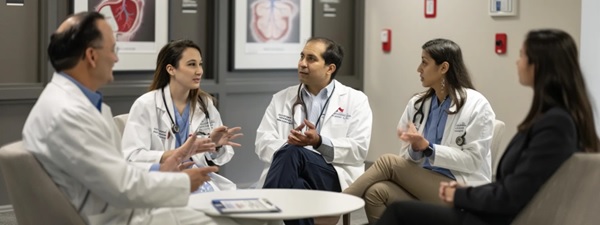Are you a fitness enthusiast or a dedicated athlete who has suddenly been sidelined by a nagging, persistent pain in your calf and ankle? That sharp or aching sensation that flares up during or after activity could be the result of Achilles tendonitis. The Achilles...
We’ve all seen soccer players sidelined by common but painful injuries like ankle sprains, knee ligament tears, and muscle strains. The combination of running, sudden stops, quick cuts, and potential physical contact makes the body, particularly the lower extremities,...
Spinal cord injuries are among the most serious and life-altering injuries a person can sustain. The spinal cord, a complex bundle of nerves, is the primary pathway for communication between the brain and the rest of the body. When it’s damaged, a patient could be...
September is National Vascular Disease Awareness Month

As September starts, it’s National Vascular Disease Awareness Month. This is a great time to learn about the health of our veins and arteries. Vascular diseases include problems like deep vein thrombosis and peripheral arterial disease. Read on to learn how to keep your veins and arteries healthy.
Understanding the Importance of Vascular Health
Your vascular system includes arteries, veins, and capillaries which are responsible for carrying, blood throughout your body. Conditions such as high blood pressure, smoking, and not getting enough exercise can harm your vascular health and lead to serious health issues such as deep vein thrombosis and varicose veins. Knowing the signs of these issues can help you get treatment early. Chronic Venous Disease (CVD), for example, can become very painful if not treated. CVD is a medical condition involving blood flow that affects the veins in your lower extremities (legs, feet, etc.) Vascular care clinics can help keep your veins and arteries in good shape.
Identify Key Factors That Affect Vascular Health
Arteries and veins are like highways for blood in your body. How well they work can be affected by your lifestyle and genetics. During a leg arterial and venous check-up, specialists see how well your blood vessels are doing. Finding problems early can help prevent them from getting worse.
Recognize Symptoms and Early Warning Signs
Watching for the signs of vascular disease can be very important. Symptoms like leg pain while walking, numbness in your limbs, wounds that don’t heal, or changes in skin color should be checked by a doctor. There are tests that doctors use that can check your blood flow and pressure. If you have a vascular condition that’s affecting your health, treatments like angioplasty and stenting may help. Angioplasty uses a balloon to open up blocked arteries, and stenting puts a tiny tube in the artery to keep it open. Early treatment can help manage and improve your vascular health.
The Impact of Diet and Exercise on Vascular Disease Prevention
Eating healthy foods and exercising can help prevent vascular disease. The type of foods you eat may affect your blood pressure and cholesterol levels, which are important for avoiding problems like chronic venous insufficiency (leg veins are not working to get blood back to the heart) and varicose veins (bulging enlarged veins). Regular exercise can help with blood flow, reduce symptoms, and slow down these conditions. By checking your vascular health regularly and making lifestyle changes, you can improve your circulation and protect yourself from vascular diseases.
Outline a Heart-Healthy Diet Plan
Eating heart-healthy foods are important for vein and artery health. Include fruits, vegetables, whole grains, and lean proteins to your diet. These foods support good blood flow and help prevent circulatory problems. Experts often recommend diets low in sodium and saturated fats, but high in omega-3 fatty acids (found in fish and flaxseed), which help keep your arteries healthy.
Regular Exercises for Improving Vascular Health
Getting regular exercise can reduce your risk of vascular diseases. Activities like swimming, cycling, and walking improve circulation and help with leg swelling and pain. Regular movement helps you stay aware of your body and can aid in early detection of vein problems.
Ways to Participate in Vascular Disease Awareness Month
September is a great time to help raise awareness about vascular diseases. You can Share educational resources on social media and highlight minimally invasive treatments. Your actions can boost awareness and encourage people to take proactive steps for their vascular health.
Regular Medical Check-Ups Among At-Risk Groups
If you’re at high risk for vascular diseases, regular medical check-ups are important. Certain medical conditions can be managed with treatments if detected early. Also, there are medications available that can help prevent strokes and blood clots. Please consult with your primary care physician for more information on these medications and treatments
